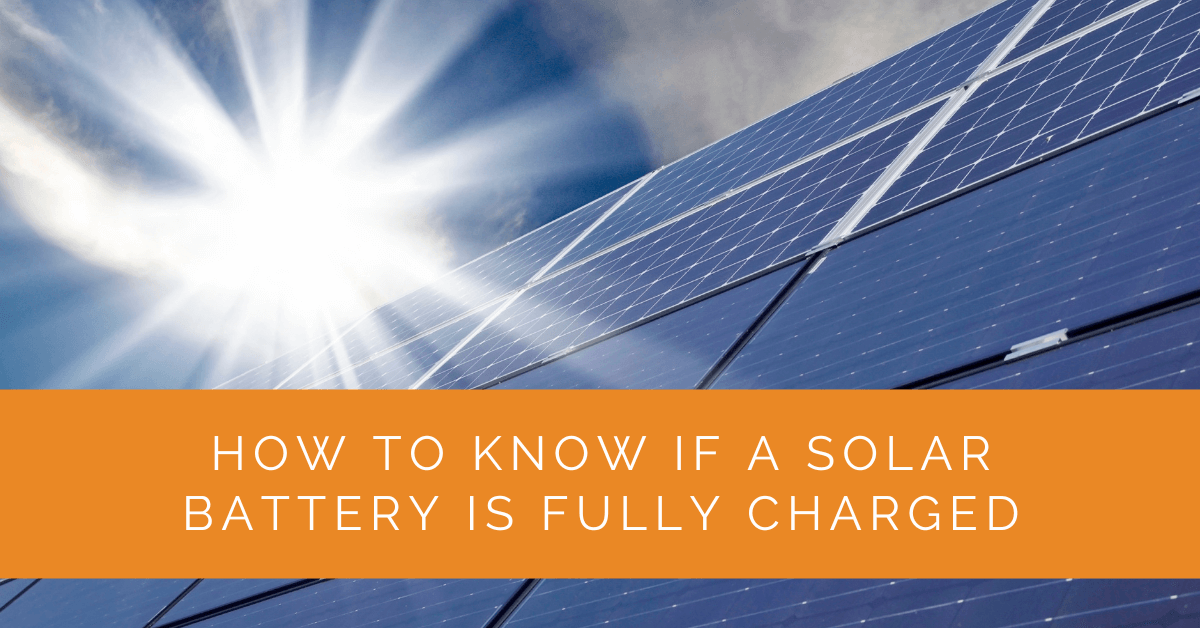Are you curious about how to determine if your solar battery is fully charged? Monitoring the state of charge of your solar batteries is crucial to ensure optimal performance and make the most of your solar power system. This article will guide you through checking if your solar battery is fully charged using various methods and tools. Let’s dive in!
Contents
- 1 Key Takeaways
- 2 Understanding Solar Batteries and Charging Process
- 3 Checking Battery Voltage
- 4 Monitoring the State of Charge
- 5 Evaluating Excess Energy
- 6 Time Taken to Fully Charge a Solar Panel Battery
- 7 Additional Tips for Battery Monitoring
- 8 Case Study: Optimizing Solar Battery Management
- 9 Expert Insights From Our Solar Panel Installers About Knowing if a Solar Battery is Fully Charged
- 10 Experience Solar Excellence with Us!
- 11 Conclusion
Key Takeaways
- Monitoring the battery voltage using a multimeter and utilizing the indicators provided by your solar charge controller are effective methods to determine if your solar battery is fully charged.
- Evaluating excess energy and optimizing its usage can maximize the benefits of your solar power system.
- Factors such as battery capacity, solar panel output, available sunlight, and charging efficiency influence the time to charge a solar battery fully.
Understanding Solar Batteries and Charging Process
Solar batteries are an essential component of a solar power system, as they store the energy generated by solar panels for later use. Understanding the charging process of solar batteries is crucial to optimize their performance and extend their lifespan.
How Solar Panels Charge Batteries
Solar panels, also known as photovoltaic (PV) panels, convert sunlight into electrical energy through the photovoltaic effect. When sunlight hits the solar cells within the panels, the photons in the light knock electrons loose from atoms, generating electricity.
To charge a solar battery, the solar panels’ direct current (DC) electricity is sent to the battery through a solar charge controller. The charge controller regulates the charging process by controlling the voltage and current flowing into the battery. This ensures that the battery is charged optimally and prevents overcharging, which can damage the battery.
The Role of Solar Charge Controllers
Solar charge controllers are crucial for the efficient charging of solar batteries. They act as the intermediary between the solar panels and the battery, regulating the flow of electricity. Charge controllers come in two main types: PWM (Pulse Width Modulation) and MPPT (Maximum Power Point Tracking).
- PWM Charge Controllers: These controllers regulate the charging process by rapidly switching the solar panel’s current on and off. They maintain a relatively constant voltage and adjust the width of the pulses to control the amount of current entering the battery.
- MPPT Charge Controllers: MPPT controllers are more advanced and efficient. They track the maximum power point of the solar panel array and adjust the voltage and current accordingly to maximize the power transfer to the battery. MPPT controllers are especially beneficial when the solar panel voltage exceeds the battery voltage.
The Significance of Battery Voltage and State of Charge
Battery voltage is a critical parameter to monitor as it provides valuable insights into the battery’s state of charge. A fully charged lead-acid battery typically has a voltage of around 12.6 to 12.8 volts, while a discharged battery may have a voltage as low as 11.5 volts.
Monitoring the battery voltage allows you to assess its state of charge and take appropriate action if necessary. It is important to note that battery voltage alone is not always a reliable indicator of the battery’s state of charge, especially under varying load conditions. To get a more accurate picture, it’s recommended to use additional methods, such as monitoring the state of charge through the solar charge controller or battery monitoring systems.

Checking Battery Voltage
Checking the voltage of your solar battery is a straightforward method to assess its state of charge. Here’s a step-by-step guide on how to check the battery voltage using a multimeter:
- Set the multimeter to the DC voltage range: Ensure that your multimeter is set to measure DC voltage, as solar batteries operate on direct current.
- Connect the multimeter probes to the battery terminals: Take the red probe (positive) of the multimeter and connect it to the battery’s positive terminal. Then, connect the black probe (negative) to the battery’s negative terminal. Make sure to match the correct polarity.
- Read the voltage displayed on the multimeter: Once the probes are properly connected, the multimeter will display the voltage reading of the battery. Take note of the value.
It is important to perform this measurement under normal operating conditions, without any heavy load connected to the battery. Also, remember that the battery voltage can vary slightly depending on temperature and battery age.
Monitoring the State of Charge
While checking the battery voltage gives you a general idea of the battery’s state of charge, it’s also essential to utilize the monitoring features provided by your solar charge controller.
Monitoring the state of charge through your solar charge controller offers more accurate and comprehensive information about your battery’s charging status. Solar charge controllers often come with built-in indicators or display screens that provide valuable insights into the state of charge. Here are some common features and indicators to look out for:
- LED Indicators: Solar charge controllers may have LED lights that indicate different charging states. These indicators can help you quickly determine if the battery is fully charged or requires further charging. For example, a green LED light may indicate a fully charged battery, while a red or flashing LED light may indicate a low charge or an ongoing charging process.
- Digital Displays: Some solar charge controllers are equipped with digital displays that provide real-time information about the battery’s voltage, current, and state of charge. These displays make it easier to monitor the battery’s status at a glance.
- Battery Voltage Readings: Solar charge controllers often provide voltage readings of the battery, allowing you to monitor the state of charge more accurately. By comparing the displayed voltage with the battery’s nominal voltage, you can assess if the battery is fully charged or requires further charging.
- State of Charge (SOC) Readings: Advanced solar charge controllers may include state of charge readings, which indicate the battery’s charging level as a percentage. This percentage represents the energy stored in the battery and can give you a clearer understanding of its state of charge.
Make sure to refer to the user manual or documentation provided by your solar charge controller manufacturer to understand the specific indicators and how to interpret them correctly. Each charge controller may have its features and indicators, so it’s essential to become familiar with the one installed in your solar power system.
By utilizing the monitoring features of your solar charge controller, you can gain valuable insights into the state of charge of your solar battery and make informed decisions regarding its usage and charging.
Evaluating Excess Energy
Solar panels often generate more energy than your immediate consumption needs. This excess energy can be effectively utilized by charging your battery, powering other devices, or feeding it back into the grid. Evaluating and managing excess energy is essential to maximize the benefits of your solar power system.
One way to evaluate excess energy is by monitoring the charging process of your solar battery. When the battery is fully charged, the solar charge controller will regulate the charging to prevent overcharging. This indicates that there is excess energy available for use.
Additionally, some advanced solar charge controllers have features like diversion load controllers, which redirect excess energy to a load (e.g., water heater, space heater, or battery bank) to utilize surplus energy efficiently. These diversion load controllers help prevent the battery from overcharging and allow you to make the most of the excess energy generated by your solar panels.
Another way to evaluate excess energy is by monitoring overall energy consumption and production. By comparing your solar panel’s output with your energy usage, you can determine if there is a surplus or deficit of energy. This information can guide you in optimizing your energy usage, storing excess energy, or even considering grid-tie systems to feed the excess energy into the grid.
Understanding and evaluating excess energy is crucial for maximizing the self-consumption of solar power, reducing reliance on the grid, and achieving greater energy efficiency.

Time Taken to Fully Charge a Solar Panel Battery
The time required to charge a solar battery fully depends on various factors, including battery capacity, solar panel output, available sunlight, and the charging efficiency of your solar power system. While it’s difficult to provide an exact timeframe, you can estimate the charging time based on the following considerations:
- Battery Capacity: The capacity of your solar battery, measured in amp-hours (Ah), determines how much energy it can store. A larger battery will generally require more time to charge than a smaller battery fully.
- Solar Panel Output: Your solar panels’ wattage rating determines how much power they can generate. Higher-wattage panels can charge the battery faster than lower-wattage panels.
- Available Sunlight: The intensity and duration of sunlight play a significant role in the charging time. A bright, sunny day with unobstructed sunlight will charge the battery faster than cloudy or shaded conditions.
- Charging Efficiency: The efficiency of your solar charge controller and the overall charging system also affect the charging time. Higher efficiency systems can convert a greater percentage of solar energy into usable power, reducing the time required to charge the battery.
To estimate the charging time, you can use the following formula as a rough guideline:
Charging Time (in hours) = Battery Capacity (in Ah) / Solar Panel Output (in A) x Charging Efficiency
It’s important to note that this formula provides an approximate estimation, and actual charging times may vary. Factors such as temperature, depth of discharge, and battery condition can also influence the charging time.
By understanding these factors and estimating the charging time, you can plan and manage your energy usage effectively, ensuring that your solar battery is adequately charged when needed.
Additional Tips for Battery Monitoring
Proper monitoring and maintenance of your solar batteries are essential for their longevity and optimal performance. Here are some additional tips to consider:
- Regularly Check the Battery Voltage: Monitoring the battery voltage is important for battery maintenance. By checking the voltage periodically, you can ensure that the battery remains within the desired voltage range and identify any potential issues.
- Perform Routine Inspections: Regularly inspect your solar panels, solar charge controller, and battery connections for any signs of damage or wear. Ensure that all connections are secure and free from corrosion. Additionally, clean the solar panels periodically to remove any dust or debris hindering their performance.
- Follow Manufacturer’s Guidelines: It’s crucial to follow the manufacturer’s battery maintenance and operation guidelines. This includes recommendations for charging profiles, temperature ranges, and maintenance procedures. Adhering to these guidelines can help maximize the lifespan and performance of your solar batteries.
- Consider Battery Monitoring Systems: Battery monitoring systems provide detailed insights into the state of charge, voltage, and other crucial parameters of your solar battery. These systems can offer real-time data and alerts, allowing you to monitor the battery’s health and performance more effectively.
- Optimize Energy Usage: By being mindful of your energy usage patterns, you can better manage your solar battery’s charging and discharging cycles. Consider adjusting the usage of energy-intensive devices during peak sunlight hours to utilize solar energy directly and minimize the strain on the battery.
By following these additional tips and best practices, you can ensure that your solar batteries operate at their best capacity and provide reliable and efficient energy for your needs.
Case Study: Optimizing Solar Battery Management
Background
At Solar Panels Network USA, we specialize in delivering tailored solar solutions that meet the unique needs of our clients. This case study focuses on a residential project where we optimized the solar battery management system to ensure maximum efficiency and longevity.
Project Overview
Our client, a homeowner committed to sustainable living, wanted to enhance their existing solar power system by adding efficient battery management. Their primary goals were to ensure their solar battery was always fully charged, maximize self-consumption, and reduce dependency on the grid.
Implementation
Energy Needs Assessment
We began with a comprehensive energy needs assessment, analyzing the client’s historical energy usage, peak demand periods, and potential for energy savings through optimized battery management.
System Design and Component Selection
Given the client’s requirements, we designed a system that included:
- High-Efficiency Solar Charge Controllers: We selected MPPT (Maximum Power Point Tracking) controllers for their superior efficiency in managing the charging process.
- Battery Monitoring System: To provide real-time data on the battery’s state of charge, voltage, and overall health, we integrated an advanced battery monitoring system.
- Energy Storage Solution: We installed a high-capacity lithium-ion battery, known for its durability and efficiency.
Installation Process
- Site Preparation: We prepared the installation site, ensuring optimal placement for the solar panels to maximize sunlight exposure.
- Component Installation: Our team installed the solar charge controllers and connected the battery monitoring system to provide detailed insights into the battery’s performance.
- System Integration: We seamlessly integrated the new components with the existing solar setup, ensuring compatibility and efficient operation.
Results
Enhanced Battery Management
With the new system in place, the client could monitor the state of charge of their solar battery accurately. The MPPT controllers ensured the battery was charged efficiently, preventing overcharging and optimizing energy storage.
Improved Energy Efficiency
The advanced battery monitoring system allowed the client to track energy production and consumption in real time. This enabled them to adjust their energy usage patterns, maximizing the self-consumption of solar power and reducing reliance on the grid.
Cost Savings and Environmental Benefits
By optimizing the charging and usage of their solar battery, the client achieved significant cost savings on their energy bills. Additionally, the efficient management of solar energy contributed to a reduction in carbon footprint, supporting their commitment to sustainable living.
Summary
Our case study highlights the successful implementation of an optimized solar battery management system for a residential client. By integrating high-efficiency solar charge controllers and an advanced battery monitoring system, we ensured the client’s solar battery remained fully charged, maximized energy efficiency, and reduced dependency on the grid. At Solar Panels Network USA, we are dedicated to providing customized solar solutions that meet the specific needs of our clients, helping them achieve energy independence and sustainability.
Expert Insights From Our Solar Panel Installers About Knowing if a Solar Battery is Fully Charged
Using a multimeter to check the voltage of your solar battery is one of the simplest and most effective ways to determine its state of charge. Regular monitoring can prevent overcharging and extend battery life.
Senior Solar Installer
Solar charge controllers are invaluable for maintaining battery health. They not only regulate the charging process but also provide real-time data on your battery’s state of charge, making it easier to manage your energy system efficiently.
Solar Energy Consultant
Evaluating excess energy and optimizing its use is crucial for maximizing the benefits of your solar power system. Properly managing this excess can help you achieve energy independence and reduce reliance on the grid.
Solar Installation Expert
Experience Solar Excellence with Us!
Trust in Solar Panels Network USA, where our seasoned experts deliver top-quality solar solutions for homes and businesses nationwide. With a legacy of countless successful installations and a commitment to sustainable energy, we’re your reliable partner in the solar journey. Ready for a brighter, eco-friendly future? Call us now at (855) 427-0058 and harness the power of the sun!
Conclusion
Knowing if your solar battery is fully charged is crucial for maximizing the efficiency and effectiveness of your solar power system. By understanding the charging process, monitoring battery voltage and state of charge, evaluating excess energy, estimating the charging time, and implementing proper battery monitoring practices, you can optimize the performance and lifespan of your solar batteries.
Regularly checking the battery voltage and utilizing the monitoring features of your solar charge controller provides valuable insights into the state of charge. Evaluating and effectively utilizing excess energy help you make the most of your solar power system. Estimating the charging time allows you to plan and manage your energy usage effectively.
About the Author
Solar Panels Network USA stands at the forefront of solar energy solutions, driven by a team of seasoned solar engineers and energy consultants. With over decades of experience in delivering high-quality solar installations and maintenance, we are committed to promoting sustainable energy through customer-centric, tailored solutions. Our articles reflect this commitment, crafted collaboratively by experts to provide accurate, up-to-date insights into solar technology, ensuring our readers are well-informed and empowered in their solar energy decisions.

